Analyzing Tesco's Business Environment: PESTLE and SWOT Report
VerifiedAdded on 2023/03/23
|10
|2316
|99
Report
AI Summary
This report presents a comprehensive analysis of Tesco's business environment. It begins with an introduction to the PESTLE model, assessing its positive and negative impacts and applying it to Tesco. The analysis covers political, economic, social, technological, legal, and environmental factors. The report then conducts internal and external analyses using SWOT to identify Tesco's strengths, weaknesses, opportunities, and threats. It also examines the relationships between these factors and external macro factors, providing a detailed SWOT analysis of Tesco. Finally, the report evaluates the impact of micro and macro factors on Tesco's business objectives, drawing conclusions based on the findings and including a complete list of references.
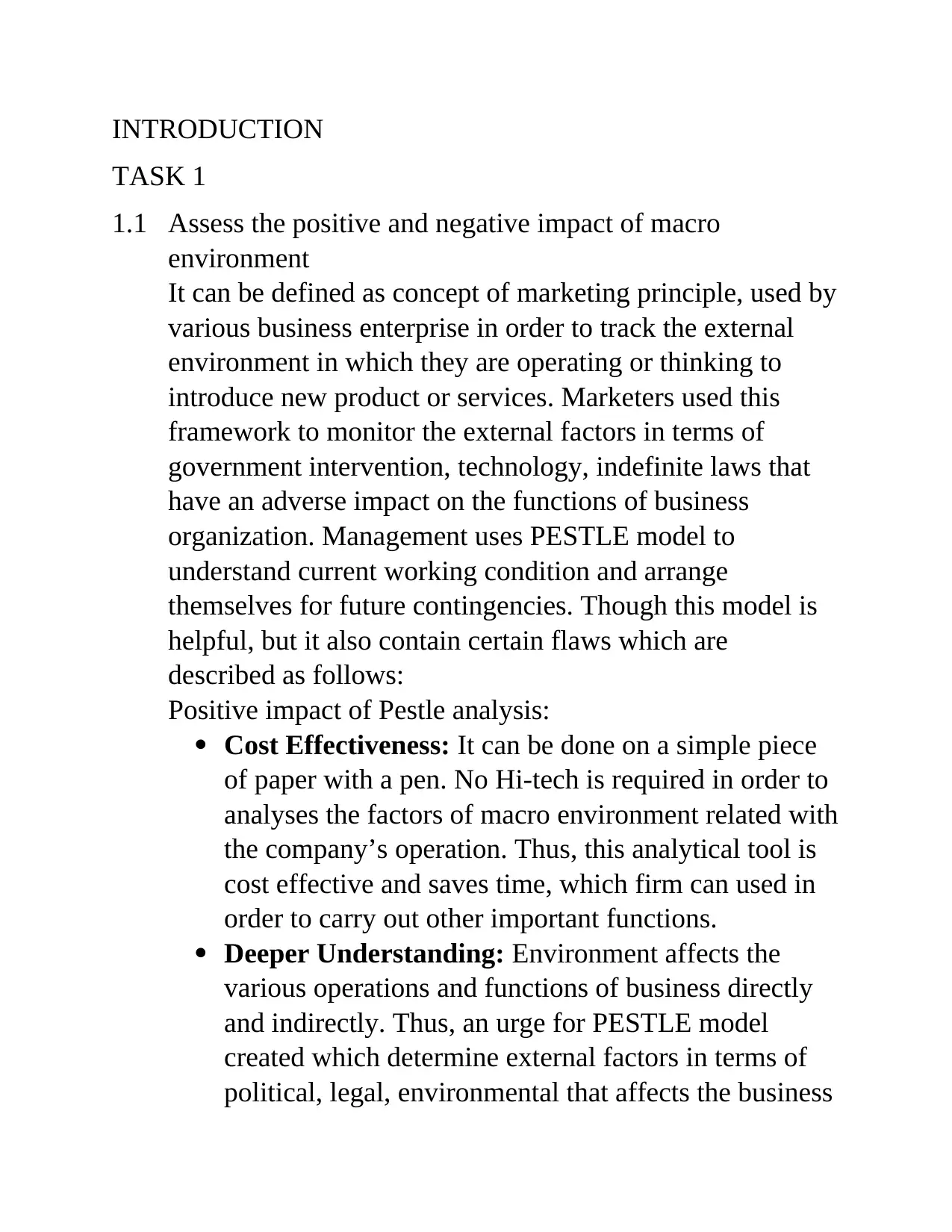
INTRODUCTION
TASK 1
1.1 Assess the positive and negative impact of macro
environment
It can be defined as concept of marketing principle, used by
various business enterprise in order to track the external
environment in which they are operating or thinking to
introduce new product or services. Marketers used this
framework to monitor the external factors in terms of
government intervention, technology, indefinite laws that
have an adverse impact on the functions of business
organization. Management uses PESTLE model to
understand current working condition and arrange
themselves for future contingencies. Though this model is
helpful, but it also contain certain flaws which are
described as follows:
Positive impact of Pestle analysis:
Cost Effectiveness: It can be done on a simple piece
of paper with a pen. No Hi-tech is required in order to
analyses the factors of macro environment related with
the company’s operation. Thus, this analytical tool is
cost effective and saves time, which firm can used in
order to carry out other important functions.
Deeper Understanding: Environment affects the
various operations and functions of business directly
and indirectly. Thus, an urge for PESTLE model
created which determine external factors in terms of
political, legal, environmental that affects the business
TASK 1
1.1 Assess the positive and negative impact of macro
environment
It can be defined as concept of marketing principle, used by
various business enterprise in order to track the external
environment in which they are operating or thinking to
introduce new product or services. Marketers used this
framework to monitor the external factors in terms of
government intervention, technology, indefinite laws that
have an adverse impact on the functions of business
organization. Management uses PESTLE model to
understand current working condition and arrange
themselves for future contingencies. Though this model is
helpful, but it also contain certain flaws which are
described as follows:
Positive impact of Pestle analysis:
Cost Effectiveness: It can be done on a simple piece
of paper with a pen. No Hi-tech is required in order to
analyses the factors of macro environment related with
the company’s operation. Thus, this analytical tool is
cost effective and saves time, which firm can used in
order to carry out other important functions.
Deeper Understanding: Environment affects the
various operations and functions of business directly
and indirectly. Thus, an urge for PESTLE model
created which determine external factors in terms of
political, legal, environmental that affects the business
Paraphrase This Document
Need a fresh take? Get an instant paraphrase of this document with our AI Paraphraser
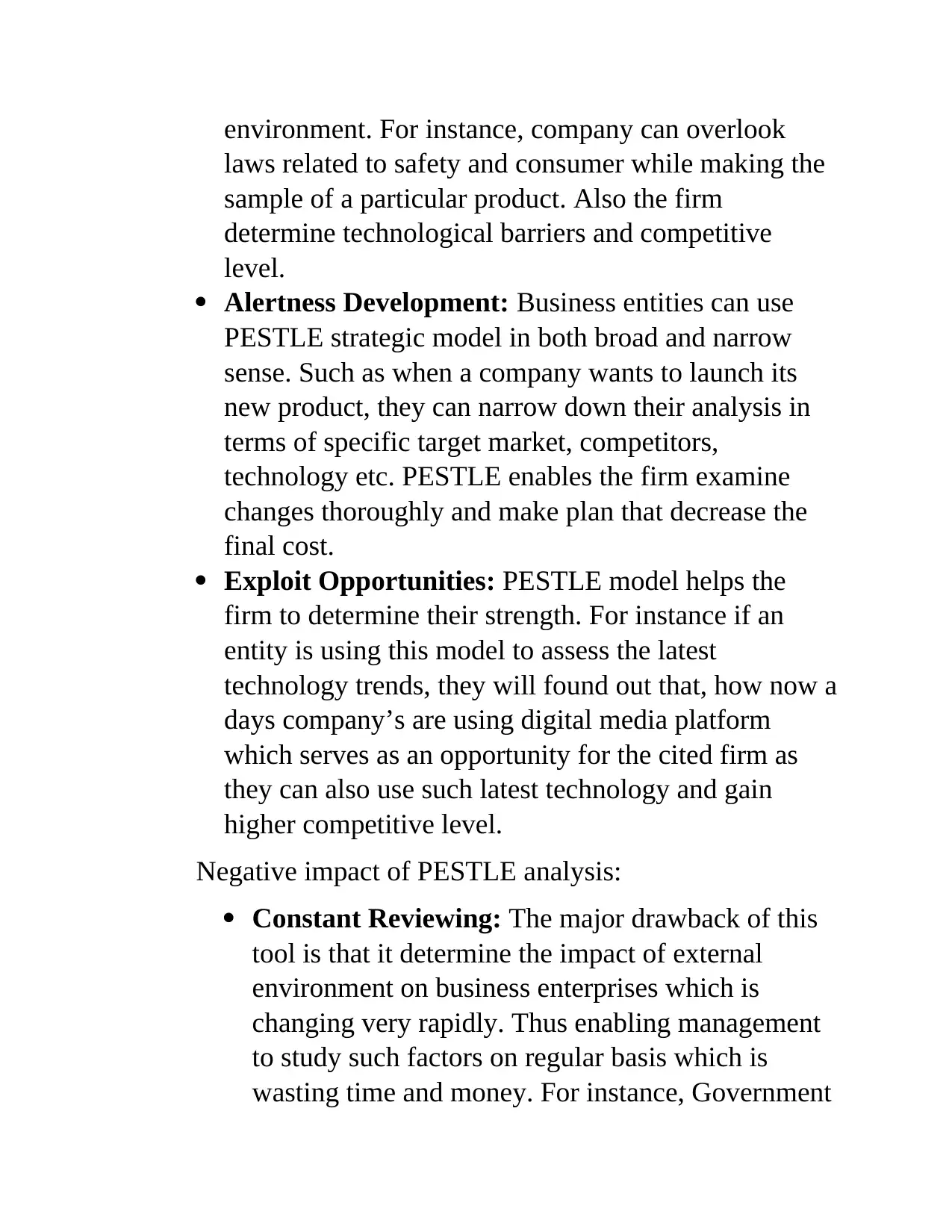
environment. For instance, company can overlook
laws related to safety and consumer while making the
sample of a particular product. Also the firm
determine technological barriers and competitive
level.
Alertness Development: Business entities can use
PESTLE strategic model in both broad and narrow
sense. Such as when a company wants to launch its
new product, they can narrow down their analysis in
terms of specific target market, competitors,
technology etc. PESTLE enables the firm examine
changes thoroughly and make plan that decrease the
final cost.
Exploit Opportunities: PESTLE model helps the
firm to determine their strength. For instance if an
entity is using this model to assess the latest
technology trends, they will found out that, how now a
days company’s are using digital media platform
which serves as an opportunity for the cited firm as
they can also use such latest technology and gain
higher competitive level.
Negative impact of PESTLE analysis:
Constant Reviewing: The major drawback of this
tool is that it determine the impact of external
environment on business enterprises which is
changing very rapidly. Thus enabling management
to study such factors on regular basis which is
wasting time and money. For instance, Government
laws related to safety and consumer while making the
sample of a particular product. Also the firm
determine technological barriers and competitive
level.
Alertness Development: Business entities can use
PESTLE strategic model in both broad and narrow
sense. Such as when a company wants to launch its
new product, they can narrow down their analysis in
terms of specific target market, competitors,
technology etc. PESTLE enables the firm examine
changes thoroughly and make plan that decrease the
final cost.
Exploit Opportunities: PESTLE model helps the
firm to determine their strength. For instance if an
entity is using this model to assess the latest
technology trends, they will found out that, how now a
days company’s are using digital media platform
which serves as an opportunity for the cited firm as
they can also use such latest technology and gain
higher competitive level.
Negative impact of PESTLE analysis:
Constant Reviewing: The major drawback of this
tool is that it determine the impact of external
environment on business enterprises which is
changing very rapidly. Thus enabling management
to study such factors on regular basis which is
wasting time and money. For instance, Government
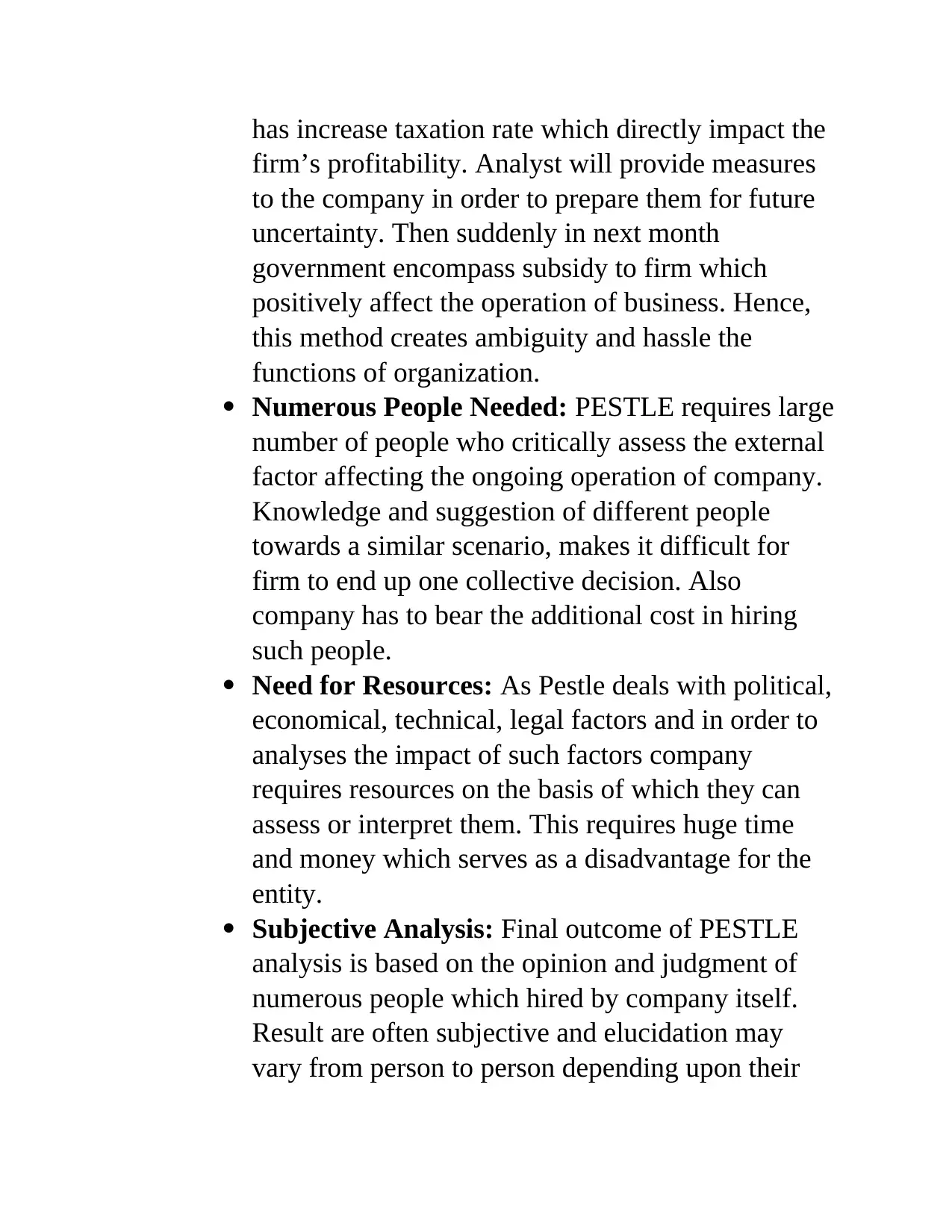
has increase taxation rate which directly impact the
firm’s profitability. Analyst will provide measures
to the company in order to prepare them for future
uncertainty. Then suddenly in next month
government encompass subsidy to firm which
positively affect the operation of business. Hence,
this method creates ambiguity and hassle the
functions of organization.
Numerous People Needed: PESTLE requires large
number of people who critically assess the external
factor affecting the ongoing operation of company.
Knowledge and suggestion of different people
towards a similar scenario, makes it difficult for
firm to end up one collective decision. Also
company has to bear the additional cost in hiring
such people.
Need for Resources: As Pestle deals with political,
economical, technical, legal factors and in order to
analyses the impact of such factors company
requires resources on the basis of which they can
assess or interpret them. This requires huge time
and money which serves as a disadvantage for the
entity.
Subjective Analysis: Final outcome of PESTLE
analysis is based on the opinion and judgment of
numerous people which hired by company itself.
Result are often subjective and elucidation may
vary from person to person depending upon their
firm’s profitability. Analyst will provide measures
to the company in order to prepare them for future
uncertainty. Then suddenly in next month
government encompass subsidy to firm which
positively affect the operation of business. Hence,
this method creates ambiguity and hassle the
functions of organization.
Numerous People Needed: PESTLE requires large
number of people who critically assess the external
factor affecting the ongoing operation of company.
Knowledge and suggestion of different people
towards a similar scenario, makes it difficult for
firm to end up one collective decision. Also
company has to bear the additional cost in hiring
such people.
Need for Resources: As Pestle deals with political,
economical, technical, legal factors and in order to
analyses the impact of such factors company
requires resources on the basis of which they can
assess or interpret them. This requires huge time
and money which serves as a disadvantage for the
entity.
Subjective Analysis: Final outcome of PESTLE
analysis is based on the opinion and judgment of
numerous people which hired by company itself.
Result are often subjective and elucidation may
vary from person to person depending upon their
⊘ This is a preview!⊘
Do you want full access?
Subscribe today to unlock all pages.

Trusted by 1+ million students worldwide
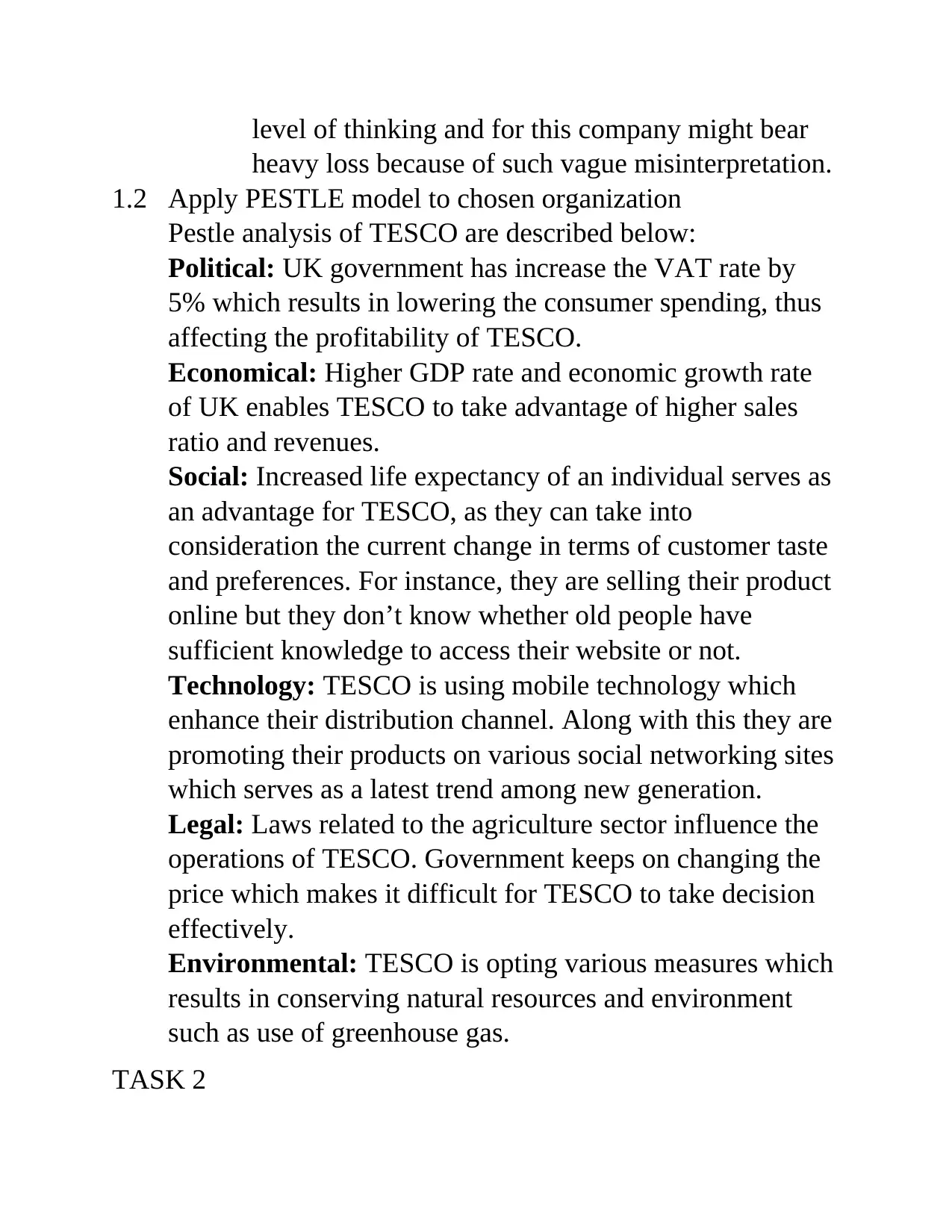
level of thinking and for this company might bear
heavy loss because of such vague misinterpretation.
1.2 Apply PESTLE model to chosen organization
Pestle analysis of TESCO are described below:
Political: UK government has increase the VAT rate by
5% which results in lowering the consumer spending, thus
affecting the profitability of TESCO.
Economical: Higher GDP rate and economic growth rate
of UK enables TESCO to take advantage of higher sales
ratio and revenues.
Social: Increased life expectancy of an individual serves as
an advantage for TESCO, as they can take into
consideration the current change in terms of customer taste
and preferences. For instance, they are selling their product
online but they don’t know whether old people have
sufficient knowledge to access their website or not.
Technology: TESCO is using mobile technology which
enhance their distribution channel. Along with this they are
promoting their products on various social networking sites
which serves as a latest trend among new generation.
Legal: Laws related to the agriculture sector influence the
operations of TESCO. Government keeps on changing the
price which makes it difficult for TESCO to take decision
effectively.
Environmental: TESCO is opting various measures which
results in conserving natural resources and environment
such as use of greenhouse gas.
TASK 2
heavy loss because of such vague misinterpretation.
1.2 Apply PESTLE model to chosen organization
Pestle analysis of TESCO are described below:
Political: UK government has increase the VAT rate by
5% which results in lowering the consumer spending, thus
affecting the profitability of TESCO.
Economical: Higher GDP rate and economic growth rate
of UK enables TESCO to take advantage of higher sales
ratio and revenues.
Social: Increased life expectancy of an individual serves as
an advantage for TESCO, as they can take into
consideration the current change in terms of customer taste
and preferences. For instance, they are selling their product
online but they don’t know whether old people have
sufficient knowledge to access their website or not.
Technology: TESCO is using mobile technology which
enhance their distribution channel. Along with this they are
promoting their products on various social networking sites
which serves as a latest trend among new generation.
Legal: Laws related to the agriculture sector influence the
operations of TESCO. Government keeps on changing the
price which makes it difficult for TESCO to take decision
effectively.
Environmental: TESCO is opting various measures which
results in conserving natural resources and environment
such as use of greenhouse gas.
TASK 2
Paraphrase This Document
Need a fresh take? Get an instant paraphrase of this document with our AI Paraphraser
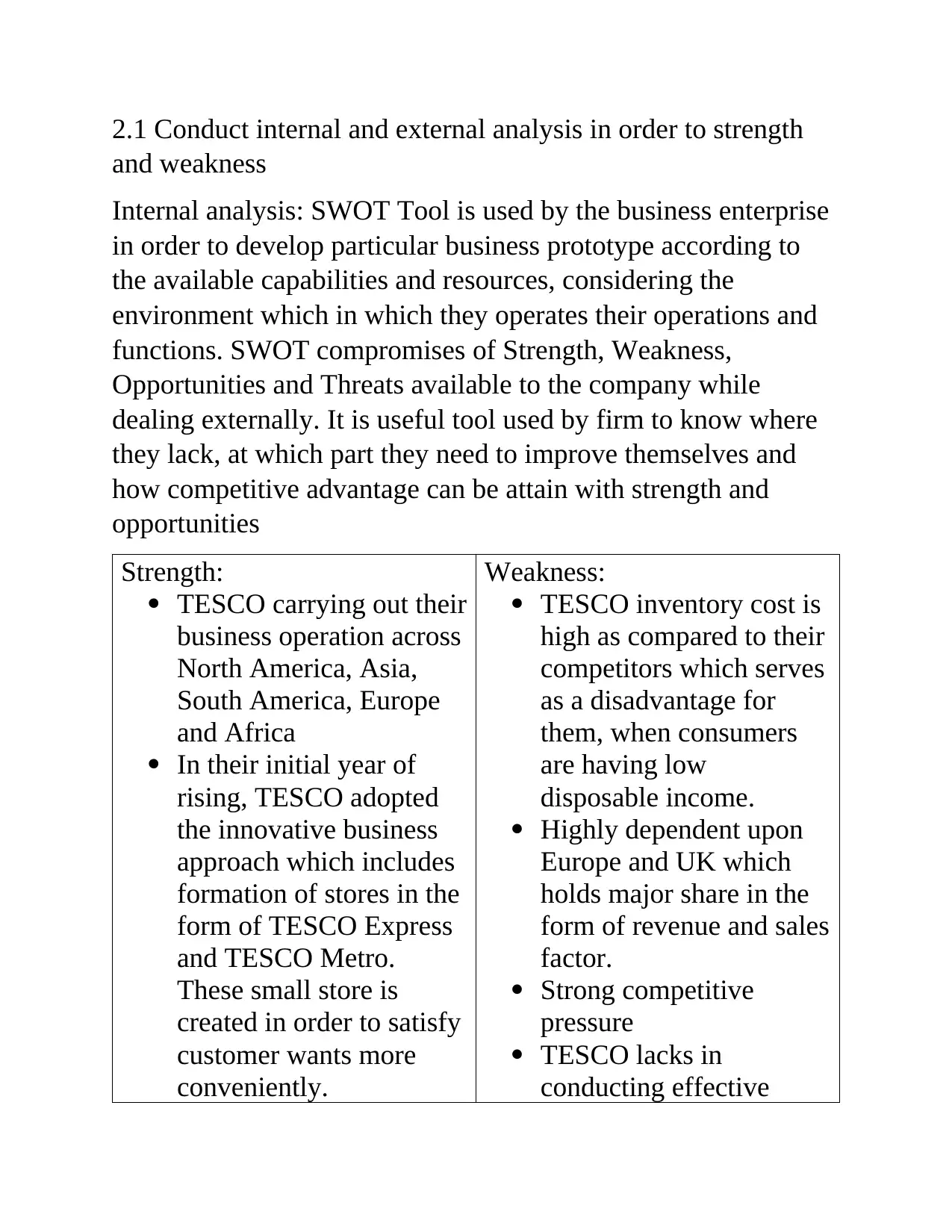
2.1 Conduct internal and external analysis in order to strength
and weakness
Internal analysis: SWOT Tool is used by the business enterprise
in order to develop particular business prototype according to
the available capabilities and resources, considering the
environment which in which they operates their operations and
functions. SWOT compromises of Strength, Weakness,
Opportunities and Threats available to the company while
dealing externally. It is useful tool used by firm to know where
they lack, at which part they need to improve themselves and
how competitive advantage can be attain with strength and
opportunities
Strength:
TESCO carrying out their
business operation across
North America, Asia,
South America, Europe
and Africa
In their initial year of
rising, TESCO adopted
the innovative business
approach which includes
formation of stores in the
form of TESCO Express
and TESCO Metro.
These small store is
created in order to satisfy
customer wants more
conveniently.
Weakness:
TESCO inventory cost is
high as compared to their
competitors which serves
as a disadvantage for
them, when consumers
are having low
disposable income.
Highly dependent upon
Europe and UK which
holds major share in the
form of revenue and sales
factor.
Strong competitive
pressure
TESCO lacks in
conducting effective
and weakness
Internal analysis: SWOT Tool is used by the business enterprise
in order to develop particular business prototype according to
the available capabilities and resources, considering the
environment which in which they operates their operations and
functions. SWOT compromises of Strength, Weakness,
Opportunities and Threats available to the company while
dealing externally. It is useful tool used by firm to know where
they lack, at which part they need to improve themselves and
how competitive advantage can be attain with strength and
opportunities
Strength:
TESCO carrying out their
business operation across
North America, Asia,
South America, Europe
and Africa
In their initial year of
rising, TESCO adopted
the innovative business
approach which includes
formation of stores in the
form of TESCO Express
and TESCO Metro.
These small store is
created in order to satisfy
customer wants more
conveniently.
Weakness:
TESCO inventory cost is
high as compared to their
competitors which serves
as a disadvantage for
them, when consumers
are having low
disposable income.
Highly dependent upon
Europe and UK which
holds major share in the
form of revenue and sales
factor.
Strong competitive
pressure
TESCO lacks in
conducting effective
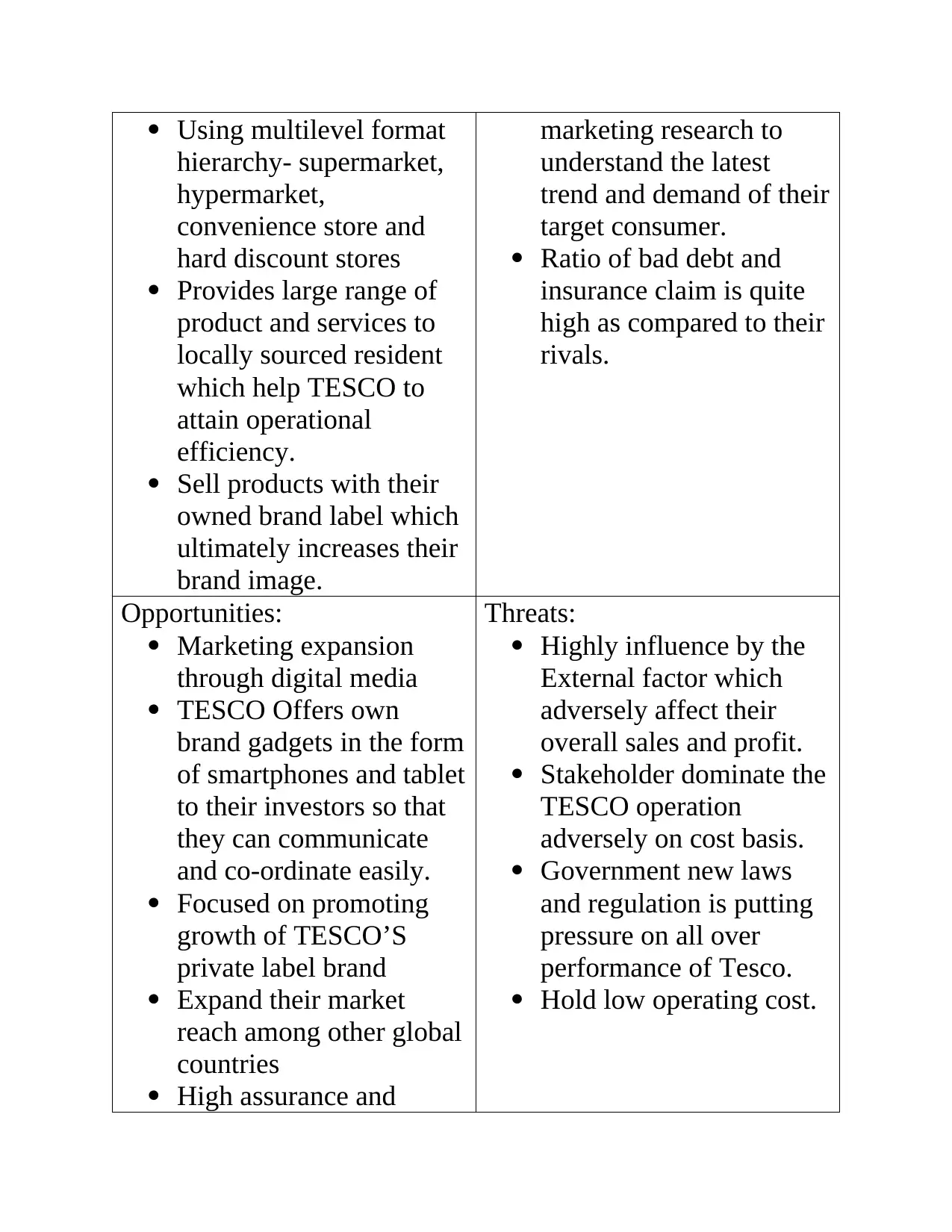
Using multilevel format
hierarchy- supermarket,
hypermarket,
convenience store and
hard discount stores
Provides large range of
product and services to
locally sourced resident
which help TESCO to
attain operational
efficiency.
Sell products with their
owned brand label which
ultimately increases their
brand image.
marketing research to
understand the latest
trend and demand of their
target consumer.
Ratio of bad debt and
insurance claim is quite
high as compared to their
rivals.
Opportunities:
Marketing expansion
through digital media
TESCO Offers own
brand gadgets in the form
of smartphones and tablet
to their investors so that
they can communicate
and co-ordinate easily.
Focused on promoting
growth of TESCO’S
private label brand
Expand their market
reach among other global
countries
High assurance and
Threats:
Highly influence by the
External factor which
adversely affect their
overall sales and profit.
Stakeholder dominate the
TESCO operation
adversely on cost basis.
Government new laws
and regulation is putting
pressure on all over
performance of Tesco.
Hold low operating cost.
hierarchy- supermarket,
hypermarket,
convenience store and
hard discount stores
Provides large range of
product and services to
locally sourced resident
which help TESCO to
attain operational
efficiency.
Sell products with their
owned brand label which
ultimately increases their
brand image.
marketing research to
understand the latest
trend and demand of their
target consumer.
Ratio of bad debt and
insurance claim is quite
high as compared to their
rivals.
Opportunities:
Marketing expansion
through digital media
TESCO Offers own
brand gadgets in the form
of smartphones and tablet
to their investors so that
they can communicate
and co-ordinate easily.
Focused on promoting
growth of TESCO’S
private label brand
Expand their market
reach among other global
countries
High assurance and
Threats:
Highly influence by the
External factor which
adversely affect their
overall sales and profit.
Stakeholder dominate the
TESCO operation
adversely on cost basis.
Government new laws
and regulation is putting
pressure on all over
performance of Tesco.
Hold low operating cost.
⊘ This is a preview!⊘
Do you want full access?
Subscribe today to unlock all pages.

Trusted by 1+ million students worldwide
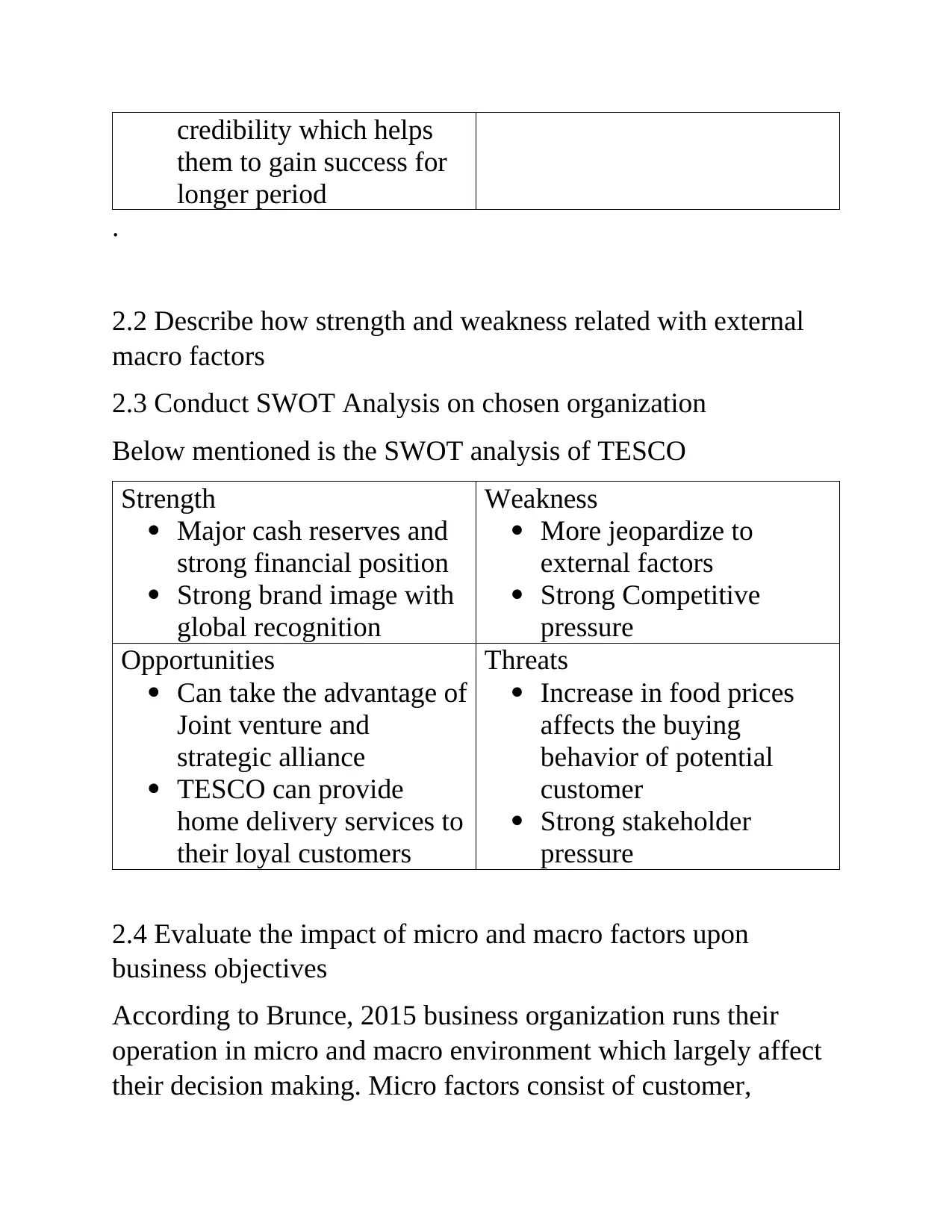
credibility which helps
them to gain success for
longer period
.
2.2 Describe how strength and weakness related with external
macro factors
2.3 Conduct SWOT Analysis on chosen organization
Below mentioned is the SWOT analysis of TESCO
Strength
Major cash reserves and
strong financial position
Strong brand image with
global recognition
Weakness
More jeopardize to
external factors
Strong Competitive
pressure
Opportunities
Can take the advantage of
Joint venture and
strategic alliance
TESCO can provide
home delivery services to
their loyal customers
Threats
Increase in food prices
affects the buying
behavior of potential
customer
Strong stakeholder
pressure
2.4 Evaluate the impact of micro and macro factors upon
business objectives
According to Brunce, 2015 business organization runs their
operation in micro and macro environment which largely affect
their decision making. Micro factors consist of customer,
them to gain success for
longer period
.
2.2 Describe how strength and weakness related with external
macro factors
2.3 Conduct SWOT Analysis on chosen organization
Below mentioned is the SWOT analysis of TESCO
Strength
Major cash reserves and
strong financial position
Strong brand image with
global recognition
Weakness
More jeopardize to
external factors
Strong Competitive
pressure
Opportunities
Can take the advantage of
Joint venture and
strategic alliance
TESCO can provide
home delivery services to
their loyal customers
Threats
Increase in food prices
affects the buying
behavior of potential
customer
Strong stakeholder
pressure
2.4 Evaluate the impact of micro and macro factors upon
business objectives
According to Brunce, 2015 business organization runs their
operation in micro and macro environment which largely affect
their decision making. Micro factors consist of customer,
Paraphrase This Document
Need a fresh take? Get an instant paraphrase of this document with our AI Paraphraser
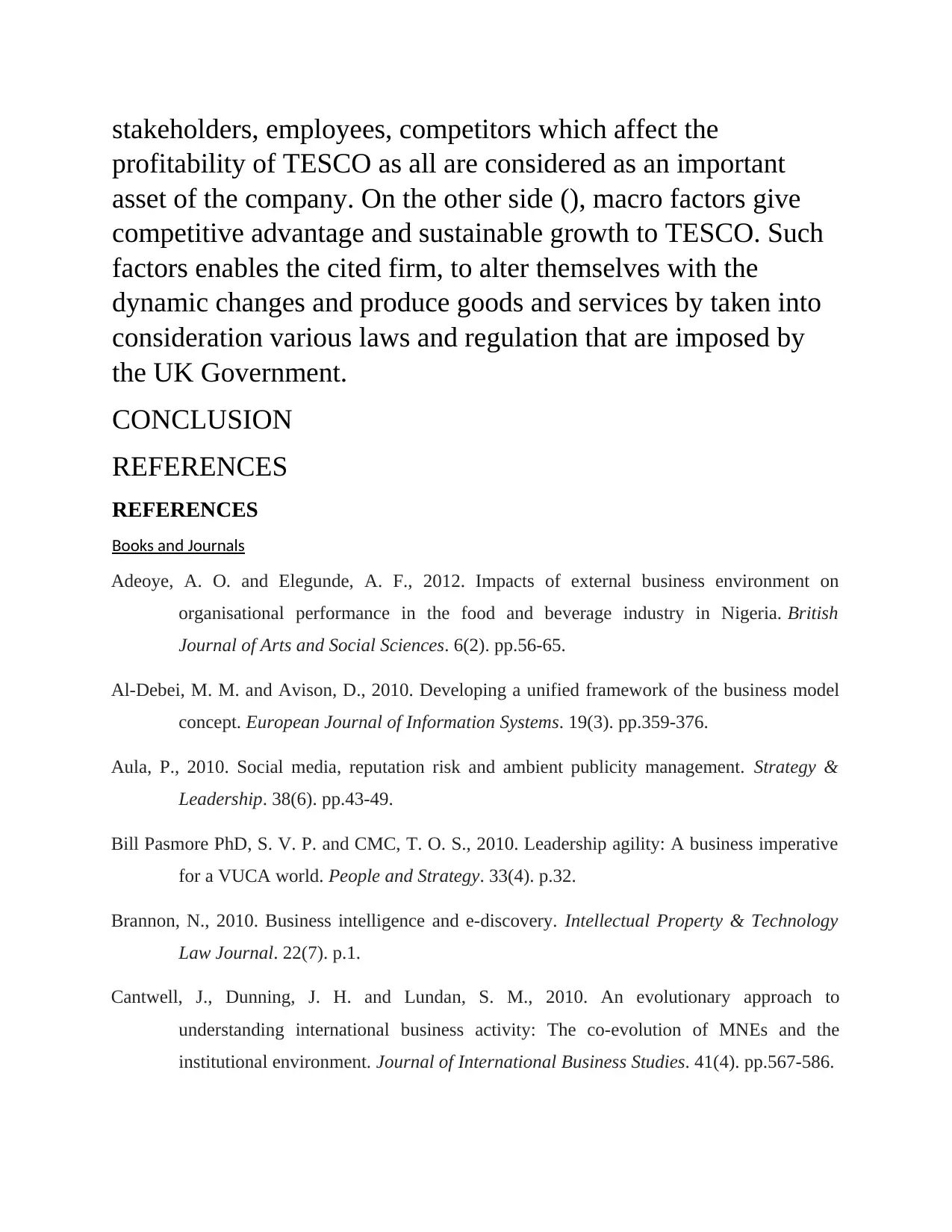
stakeholders, employees, competitors which affect the
profitability of TESCO as all are considered as an important
asset of the company. On the other side (), macro factors give
competitive advantage and sustainable growth to TESCO. Such
factors enables the cited firm, to alter themselves with the
dynamic changes and produce goods and services by taken into
consideration various laws and regulation that are imposed by
the UK Government.
CONCLUSION
REFERENCES
REFERENCES
Books and Journals
Adeoye, A. O. and Elegunde, A. F., 2012. Impacts of external business environment on
organisational performance in the food and beverage industry in Nigeria. British
Journal of Arts and Social Sciences. 6(2). pp.56-65.
Al-Debei, M. M. and Avison, D., 2010. Developing a unified framework of the business model
concept. European Journal of Information Systems. 19(3). pp.359-376.
Aula, P., 2010. Social media, reputation risk and ambient publicity management. Strategy &
Leadership. 38(6). pp.43-49.
Bill Pasmore PhD, S. V. P. and CMC, T. O. S., 2010. Leadership agility: A business imperative
for a VUCA world. People and Strategy. 33(4). p.32.
Brannon, N., 2010. Business intelligence and e-discovery. Intellectual Property & Technology
Law Journal. 22(7). p.1.
Cantwell, J., Dunning, J. H. and Lundan, S. M., 2010. An evolutionary approach to
understanding international business activity: The co-evolution of MNEs and the
institutional environment. Journal of International Business Studies. 41(4). pp.567-586.
profitability of TESCO as all are considered as an important
asset of the company. On the other side (), macro factors give
competitive advantage and sustainable growth to TESCO. Such
factors enables the cited firm, to alter themselves with the
dynamic changes and produce goods and services by taken into
consideration various laws and regulation that are imposed by
the UK Government.
CONCLUSION
REFERENCES
REFERENCES
Books and Journals
Adeoye, A. O. and Elegunde, A. F., 2012. Impacts of external business environment on
organisational performance in the food and beverage industry in Nigeria. British
Journal of Arts and Social Sciences. 6(2). pp.56-65.
Al-Debei, M. M. and Avison, D., 2010. Developing a unified framework of the business model
concept. European Journal of Information Systems. 19(3). pp.359-376.
Aula, P., 2010. Social media, reputation risk and ambient publicity management. Strategy &
Leadership. 38(6). pp.43-49.
Bill Pasmore PhD, S. V. P. and CMC, T. O. S., 2010. Leadership agility: A business imperative
for a VUCA world. People and Strategy. 33(4). p.32.
Brannon, N., 2010. Business intelligence and e-discovery. Intellectual Property & Technology
Law Journal. 22(7). p.1.
Cantwell, J., Dunning, J. H. and Lundan, S. M., 2010. An evolutionary approach to
understanding international business activity: The co-evolution of MNEs and the
institutional environment. Journal of International Business Studies. 41(4). pp.567-586.
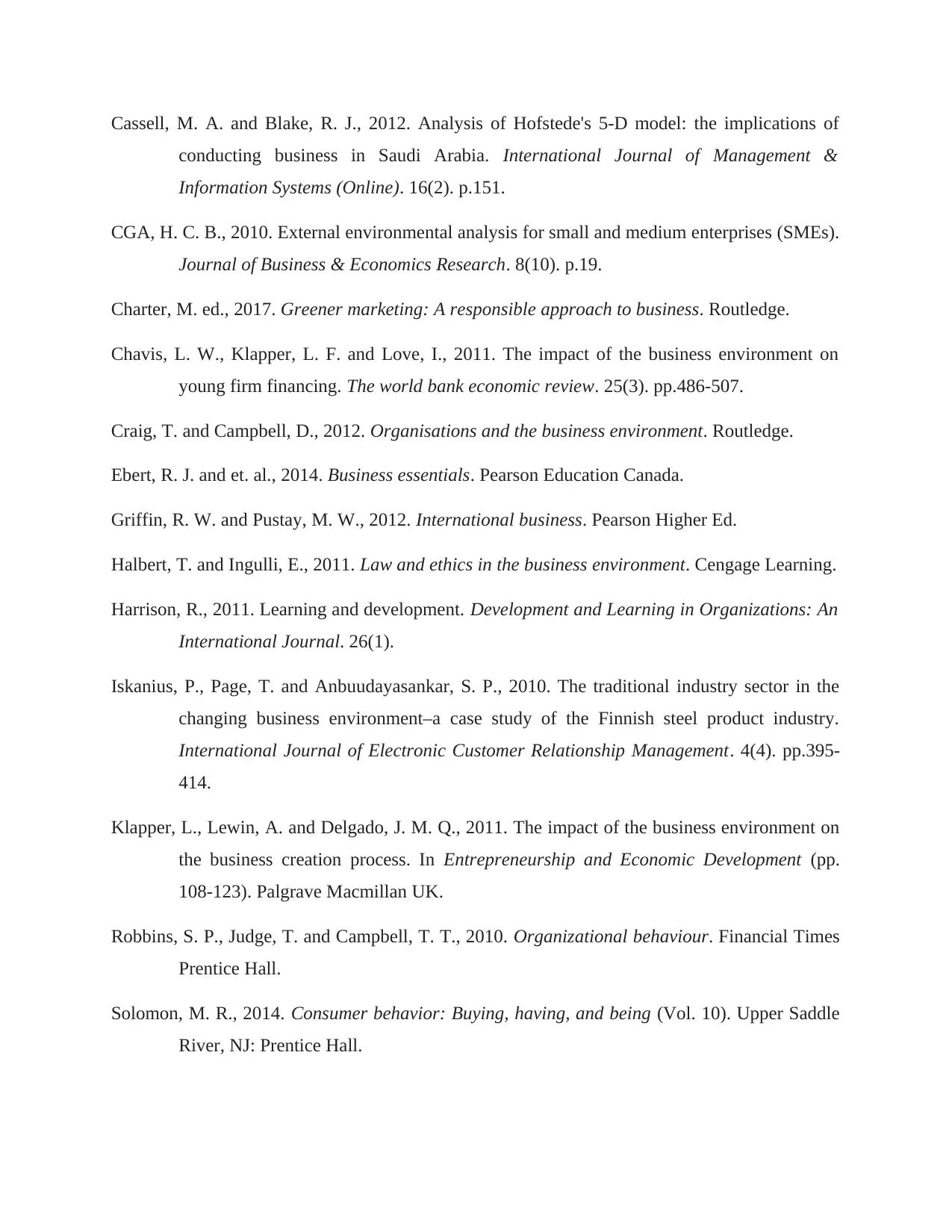
Cassell, M. A. and Blake, R. J., 2012. Analysis of Hofstede's 5-D model: the implications of
conducting business in Saudi Arabia. International Journal of Management &
Information Systems (Online). 16(2). p.151.
CGA, H. C. B., 2010. External environmental analysis for small and medium enterprises (SMEs).
Journal of Business & Economics Research. 8(10). p.19.
Charter, M. ed., 2017. Greener marketing: A responsible approach to business. Routledge.
Chavis, L. W., Klapper, L. F. and Love, I., 2011. The impact of the business environment on
young firm financing. The world bank economic review. 25(3). pp.486-507.
Craig, T. and Campbell, D., 2012. Organisations and the business environment. Routledge.
Ebert, R. J. and et. al., 2014. Business essentials. Pearson Education Canada.
Griffin, R. W. and Pustay, M. W., 2012. International business. Pearson Higher Ed.
Halbert, T. and Ingulli, E., 2011. Law and ethics in the business environment. Cengage Learning.
Harrison, R., 2011. Learning and development. Development and Learning in Organizations: An
International Journal. 26(1).
Iskanius, P., Page, T. and Anbuudayasankar, S. P., 2010. The traditional industry sector in the
changing business environment–a case study of the Finnish steel product industry.
International Journal of Electronic Customer Relationship Management. 4(4). pp.395-
414.
Klapper, L., Lewin, A. and Delgado, J. M. Q., 2011. The impact of the business environment on
the business creation process. In Entrepreneurship and Economic Development (pp.
108-123). Palgrave Macmillan UK.
Robbins, S. P., Judge, T. and Campbell, T. T., 2010. Organizational behaviour. Financial Times
Prentice Hall.
Solomon, M. R., 2014. Consumer behavior: Buying, having, and being (Vol. 10). Upper Saddle
River, NJ: Prentice Hall.
conducting business in Saudi Arabia. International Journal of Management &
Information Systems (Online). 16(2). p.151.
CGA, H. C. B., 2010. External environmental analysis for small and medium enterprises (SMEs).
Journal of Business & Economics Research. 8(10). p.19.
Charter, M. ed., 2017. Greener marketing: A responsible approach to business. Routledge.
Chavis, L. W., Klapper, L. F. and Love, I., 2011. The impact of the business environment on
young firm financing. The world bank economic review. 25(3). pp.486-507.
Craig, T. and Campbell, D., 2012. Organisations and the business environment. Routledge.
Ebert, R. J. and et. al., 2014. Business essentials. Pearson Education Canada.
Griffin, R. W. and Pustay, M. W., 2012. International business. Pearson Higher Ed.
Halbert, T. and Ingulli, E., 2011. Law and ethics in the business environment. Cengage Learning.
Harrison, R., 2011. Learning and development. Development and Learning in Organizations: An
International Journal. 26(1).
Iskanius, P., Page, T. and Anbuudayasankar, S. P., 2010. The traditional industry sector in the
changing business environment–a case study of the Finnish steel product industry.
International Journal of Electronic Customer Relationship Management. 4(4). pp.395-
414.
Klapper, L., Lewin, A. and Delgado, J. M. Q., 2011. The impact of the business environment on
the business creation process. In Entrepreneurship and Economic Development (pp.
108-123). Palgrave Macmillan UK.
Robbins, S. P., Judge, T. and Campbell, T. T., 2010. Organizational behaviour. Financial Times
Prentice Hall.
Solomon, M. R., 2014. Consumer behavior: Buying, having, and being (Vol. 10). Upper Saddle
River, NJ: Prentice Hall.
⊘ This is a preview!⊘
Do you want full access?
Subscribe today to unlock all pages.

Trusted by 1+ million students worldwide
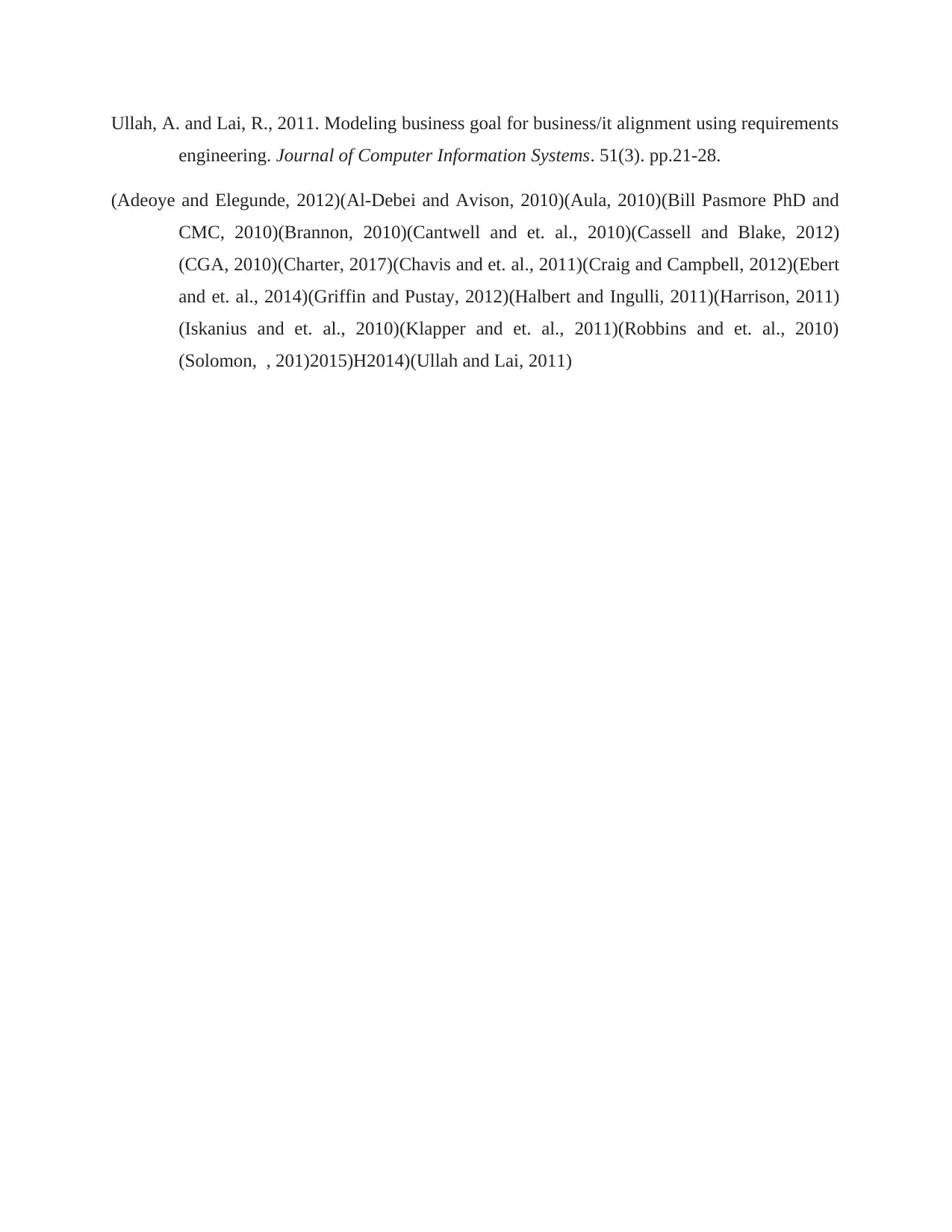
Ullah, A. and Lai, R., 2011. Modeling business goal for business/it alignment using requirements
engineering. Journal of Computer Information Systems. 51(3). pp.21-28.
(Adeoye and Elegunde, 2012)(Al-Debei and Avison, 2010)(Aula, 2010)(Bill Pasmore PhD and
CMC, 2010)(Brannon, 2010)(Cantwell and et. al., 2010)(Cassell and Blake, 2012)
(CGA, 2010)(Charter, 2017)(Chavis and et. al., 2011)(Craig and Campbell, 2012)(Ebert
and et. al., 2014)(Griffin and Pustay, 2012)(Halbert and Ingulli, 2011)(Harrison, 2011)
(Iskanius and et. al., 2010)(Klapper and et. al., 2011)(Robbins and et. al., 2010)
(Solomon, , 201)2015)H2014)(Ullah and Lai, 2011)
engineering. Journal of Computer Information Systems. 51(3). pp.21-28.
(Adeoye and Elegunde, 2012)(Al-Debei and Avison, 2010)(Aula, 2010)(Bill Pasmore PhD and
CMC, 2010)(Brannon, 2010)(Cantwell and et. al., 2010)(Cassell and Blake, 2012)
(CGA, 2010)(Charter, 2017)(Chavis and et. al., 2011)(Craig and Campbell, 2012)(Ebert
and et. al., 2014)(Griffin and Pustay, 2012)(Halbert and Ingulli, 2011)(Harrison, 2011)
(Iskanius and et. al., 2010)(Klapper and et. al., 2011)(Robbins and et. al., 2010)
(Solomon, , 201)2015)H2014)(Ullah and Lai, 2011)
1 out of 10
Related Documents
Your All-in-One AI-Powered Toolkit for Academic Success.
+13062052269
info@desklib.com
Available 24*7 on WhatsApp / Email
![[object Object]](/_next/static/media/star-bottom.7253800d.svg)
Unlock your academic potential
Copyright © 2020–2025 A2Z Services. All Rights Reserved. Developed and managed by ZUCOL.





